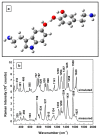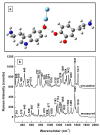Simultaneous Detection of Dopamine and Serotonin-A Comparative Experimental and Theoretical Study of Neurotransmitter Interactions
- PMID: 30587770
- PMCID: PMC6468865
- DOI: 10.3390/bios9010003
Simultaneous Detection of Dopamine and Serotonin-A Comparative Experimental and Theoretical Study of Neurotransmitter Interactions
Abstract
With the goal of accurately detecting and quantifying the amounts of dopamine (DA) and serotonin (5-HT) in mixtures of these neurotransmitters without using any labelling, we present a detailed, comparative computational and Raman experimental study. Although discrimination between these two analytes is achievable in such mixtures for concentrations in the millimolar range, their accurate quantification remains unattainable. As shown for the first time in this work, the formation of a new composite resulting from their interactions with each other is the main reason for this lack of quantification. While this new hydrogen-bonded complex further complicates potential analyte discrimination and quantification at concentrations characteristic of physiological levels (i.e., nanomolar concentrations), it can also open new avenues for its use in drug delivery and pharmaceutical research. This remark is based not only on chemical interactions analyzed here from both theoretical and experimental approaches, but also on biological relationship, with consideration of both functional and neural proximity perspectives. Thus, this research constitutes an important contribution toward better understanding of neural processes, as well as toward possible future development of label-free biosensors.
Keywords: computational analysis; dopamine; label-free optical biosensors; neurotransmitters; serotonin; simultaneous detection; surface-enhanced Raman spectroscopy.
Conflict of interest statement
The authors declare no conflict of interest.
Figures





Similar articles
-
Label-Free SERS Selective Detection of Dopamine and Serotonin Using Graphene-Au Nanopyramid Heterostructure.Anal Chem. 2015 Oct 20;87(20):10255-61. doi: 10.1021/acs.analchem.5b01560. Epub 2015 Sep 30. Anal Chem. 2015. PMID: 26382549
-
Pattern Recognition of Neurotransmitters: Complexity Reduction for Serotonin and Dopamine.Biosensors (Basel). 2025 Mar 25;15(4):209. doi: 10.3390/bios15040209. Biosensors (Basel). 2025. PMID: 40277523 Free PMC article.
-
A cyclodextrin host-guest recognition approach to an electrochemical sensor for simultaneous quantification of serotonin and dopamine.Biosens Bioelectron. 2011 Aug 15;26(12):4674-80. doi: 10.1016/j.bios.2011.04.061. Epub 2011 May 18. Biosens Bioelectron. 2011. PMID: 21715153
-
Conducting polymer-based electrochemical biosensors for neurotransmitters: A review.Biosens Bioelectron. 2018 Apr 15;102:540-552. doi: 10.1016/j.bios.2017.11.069. Epub 2017 Dec 5. Biosens Bioelectron. 2018. PMID: 29220802 Review.
-
Electrochemistry at the Synapse.Annu Rev Anal Chem (Palo Alto Calif). 2019 Jun 12;12(1):297-321. doi: 10.1146/annurev-anchem-061318-115434. Epub 2019 Feb 1. Annu Rev Anal Chem (Palo Alto Calif). 2019. PMID: 30707593 Free PMC article. Review.
Cited by
-
The highly sensitive determination of serotonin by using gold nanoparticles (Au NPs) with a localized surface plasmon resonance (LSPR) absorption wavelength in the visible region.RSC Adv. 2020 Aug 20;10(51):30858-30869. doi: 10.1039/d0ra05271j. eCollection 2020 Aug 17. RSC Adv. 2020. PMID: 35516028 Free PMC article.
-
Electrochemical Sensing of Serotonin by a Modified MnO2-Graphene Electrode.Biosensors (Basel). 2020 Apr 2;10(4):33. doi: 10.3390/bios10040033. Biosensors (Basel). 2020. PMID: 32252484 Free PMC article.
-
From Research to Diagnostic Application of Raman Spectroscopy in Neurosciences: Past and Perspectives.Free Neuropathol. 2022 Aug 5;3:19. doi: 10.17879/freeneuropathology-2022-4210. eCollection 2022 Jan. Free Neuropathol. 2022. PMID: 37284145 Free PMC article.
-
Acute and Chronic Exposure to Linagliptin, a Selective Inhibitor of Dipeptidyl Peptidase-4 (DPP-4), Has an Effect on Dopamine, Serotonin and Noradrenaline Level in the Striatum and Hippocampus of Rats.Int J Mol Sci. 2024 Mar 5;25(5):3008. doi: 10.3390/ijms25053008. Int J Mol Sci. 2024. PMID: 38474255 Free PMC article.
References
-
- Nestler E.J., Hyman S.E., Holtzman D.M., Malenka R.C. Molecular Neuropharmacology: A Foundation for Clinical Neuroscience. 3rd ed. McGraw-Hill Medical; New York, NY, USA: 2010.
Publication types
MeSH terms
Substances
Grants and funding
LinkOut - more resources
Full Text Sources
Other Literature Sources
Research Materials

